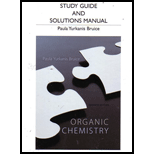
Concept explainers
(a)
Interpretation:
The mechanism for the Ritter reaction has to be proposed.
Concept introduction:
Ritter reaction is an organic reaction which is used for
the synthesis of amide. Nitrile along with alcohol or
in Ritter reaction. This reaction occurs in the acidic medium.
(b)
Interpretation:
The reason for the nonreactivity of primary alcohol in the Ritter recation is to be stated.
Concept introduction:
Carbocation are the chemical species which carries a unit positive charge on the carbon atom. The alkyl groups are electron donating groups and thus, they shows positive inductive effect. The increasing order of stability of carbocation is:
(c)
Interpretation:
Difference between the Ritter reaction and acid-catalyzed hydrolysis of a nitrile to form an amide has to be explained.
Concept introduction:
Ritter reaction occurs between nitriles and alkenes or alcohols in the acidic medium to form amide. Amide can also formed by the reaction of nitriles with water and acid.
Want to see the full answer?
Check out a sample textbook solution
Chapter 16 Solutions
Organic Chemistry
- 4. WHAT ARE IMINES? HOW ARE THEY FORMED? 5. WHAT IS GRIGNARD REACTION? WHAT CONSTITUTES A GRIGNARD REAGENT? 6. WHAT IS KETO-ENOL TAUTOMERIZATION?arrow_forwardWhat is the product of this reaction? And the best mechanism for the reaction (using carboxilic acid reactions)?arrow_forwarda. Propose a mechanism for the reaction of acetic anhydride with water.b. How does this mechanism differ from the mechanism for the reaction of acetic anhydride with an alcohol?arrow_forward
- Give the products formed when benzaldehyde and benzoic acid are treated with the given reagents. a. Tollen’s reagentb. phenylhydrazine, H+c. HCNd. NH2OHe. 1 mole H2, Nif. 1 mole CH3OH, H+g. LiAlH4 then H2O, H+h. 2 moles CH3OH, H+i. CH3MgCl, then H2O, H+j. H2Oarrow_forwardCan you help find the best reagent for this problem?arrow_forwarda) Put these three common types of carbonyl compound in order of decreasing reactivity ester amide acid chloride b) For the least reactive, show the interconversion to its other resonance form: How does this electron delocalisation make it stable? c) For the most reactive, draw the mechanism of its undergoing hydrolysis (reaction with H2O): Why makes this type of carbonyl so reactive to nucleophiles?arrow_forward
- How would I go about finding the reagents and forming the final product? arrow_forwardWhich reagents would you use to perform reaction B?a) PBr3.b) p-toluenesulfonyl chloride.c) SOCl2.d) NaOCl, NaOHarrow_forwarda. What reagent must be used in the preparation of an acid chloride from a carboxylic acid? b. Explain why this reagent is necessary. Why can;t you simply react the carboxylic acid with Cl-? COnsider the mechanism of the reaction in your explanation.arrow_forward
 Organic Chemistry: A Guided InquiryChemistryISBN:9780618974122Author:Andrei StraumanisPublisher:Cengage Learning
Organic Chemistry: A Guided InquiryChemistryISBN:9780618974122Author:Andrei StraumanisPublisher:Cengage Learning
 Organic ChemistryChemistryISBN:9781305580350Author:William H. Brown, Brent L. Iverson, Eric Anslyn, Christopher S. FootePublisher:Cengage Learning
Organic ChemistryChemistryISBN:9781305580350Author:William H. Brown, Brent L. Iverson, Eric Anslyn, Christopher S. FootePublisher:Cengage Learning


